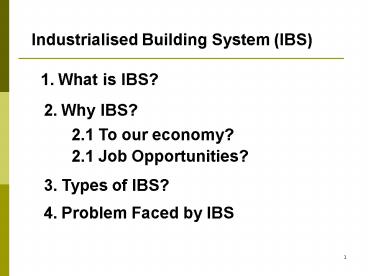Industrialised Building System IBS - PowerPoint PPT Presentation
1 / 27
Title:
Industrialised Building System IBS
Description:
c) 1851 Crystal Palace in Hyde Park, London and 1889 Eiffel Tower, Paris. 5 ... Eiffel Tower, Paris. 7. 1.2 History of IBS in Malaysia. Industrialised Building ... – PowerPoint PPT presentation
Number of Views:8304
Avg rating:5.0/5.0
Title: Industrialised Building System IBS
1
Industrialised Building System (IBS)
1. What is IBS?
2. Why IBS?
2.1 To our economy?
2.1 Job Opportunities?
3. Types of IBS?
4. Problem Faced by IBS
2
Industrialised Building System (IBS)
1. What is IBS?
A construction technique in which components are
manufactured in a controlled environment (on or
off site), transported, positioned and assembled
into a structure with minimal additional site
works
3
(No Transcript)
4
Industrialised Building System (IBS)
1.1 History of IBS
a) Concept IBS in not new and can be traced back
to as early 1624
b) In 1624, panellised timber houses were shipped
from England to the new settlement in North
America
c) 1851 Crystal Palace in Hyde Park, London and
1889 Eiffel Tower, Paris
5
Industrialised Building System (IBS)
Crystal Palace, Hyde Park
During construction 1840
Picture taken in 1851
6
Industrialised Building System (IBS)
Eiffel Tower, Paris
During construction 1878
Picture taken in 1945
7
Industrialised Building System (IBS)
1.2 History of IBS in Malaysia
a) Concept IBS in Malaysia is not new
b) In 1966 the two pilot project started by using
IBS concept. Namely?
i) Pekeliling Flat, Kuala Lumpur
ii) The Rifle Range Flat, Penang
c) In 1981-1993 PKNS acquired pre-cast concrete
technology from Praton Haus International,
Germany to built housing project
8
Industrialised Building System (IBS)
1.2 History of IBS in Malaysia
Pekeliling Flats
LRT Station
KLCC
KL Tower
9
Industrialised Building System (IBS)
1.3 Characteristics of IBS
1.3.1 Five Characteristics of IBS are
a) Industrial production of components though
prefabrication
b) Reduced labour during prefabrication of
components and site works
c) Modern design and manufacturing method using
CAD/CAM
d) Systematic Quality Control i.e ISO 9000
e) Open Building System i.e permitting hybrid
applications
10
Industrialised Building System (IBS)
2. Why IBS
Budget Speech 2005
The Government is determined to ensure that
every Malaysian will have access to affordable
homes. During the period 1971-2003, the
Government constructed 490,000 units of low-cost
houses. The government intends to provide an
additional 100,000 units of affordable homes to
be implemented through the Industrialised
Building System (IBS).This system will ensure
quality, save cost, create a safer and cleaner
working environment as well as reduce the
dependence of foreign workers
11
Industrialised Building System (IBS)
2.1 The Current Scenario of Malaysian
Construction Industry
This can contributes Messy Sites, High Wastage,
Labour Intensive, Low Quality and Delays
12
Industrialised Building System (IBS)
2.2 Social Problems
a) Currently 75 foreign workers out of 100
construction workers
b) There are 318,000 foreign workers in Malaysian
Construction Industry
Let say one foreign worker gain RM400 pe
rmonthRM400.00 x 12 months RM5,000 per
year,318,000 x RM5,000 RM 1.59 Billion per
year It shows the High outflow of Ringgit
13
Industrialised Building System (IBS)
2.3 Benefits
- Reduction of site labour
- Minimal Wastage
- Less site material
- Cleaner environment
- Controlled quality
- Neater and safer sites
- Faster project completion
- Lower total construction costs due to the above
14
Industrialised Building System (IBS)
2.4 Case Study
Parcel 5 6, Precinct 9 750 units (900
sqft) Durations 18 months
Parcel 4, Precinct 9 520 units (1000
sqft) Durations 18 months
15
Industrialised Building System (IBS)
3. Types of IBS
3.1 In general, the construction method can be
classified into 4 categories
- 1st ASSIGNMENT
- -Form a group which is consist min of 5 members.
- Each group will elaborate what is a), b), c) and
d) - Please attach pictures and references to support
your finding.
a) Conventional Method
b) Cast-in situ
c) Composite Method
d) Fully prefabricated
3.2 Method b,c and d can be classified as non
conventional methods and all types of IBSs are
categorized under these three
16
Industrialised Building System (IBS)
3. Types of IBS (contd)
3.3 The construction method can be classified
into 4 categories
17
Industrialised Building System (IBS)
3. Types of IBS (contd)
3.4 Based on structural aspects, IBS can be
divided into five major types
3.4.1 Type 1 Pre-Cast Concrete Framing, Panel
and Box System
e.g Pre-Cast Columns, Beams, Slabs, Staircase,
Toilet
18
Industrialised Building System (IBS)
3. Types of IBS (contd)
3.4.2 Type 2 Steel Formwork Systems
e.g Tunnel Formwork, Beam, Column and slab
moulding form
19
Industrialised Building System (IBS)
3. Types of IBS (contd)
3.4.3 Type 3 Steel Frame System
e.g Steel Beam, columns, portal frames, roof
trusses
20
Industrialised Building System (IBS)
3. Types of IBS (contd)
3.4.4 Type 4 Prefabricate Timber Frame System
e.g Timber frame, timber roof trusses
21
Industrialised Building System (IBS)
3. Types of IBS (contd)
3.4.5 Type 5 Blockwork Systems
e.g Interlocking concrete masonry unit (CMU),
lightweight concrete blocks
22
Industrialised Building System (IBS)
4. Problems Faced by IBS
a) Only 15 contractors using IBS, Why?
i) Lack of Expertise / Lack of Experience
ii) Cost
23
Industrialised Building System (IBS)
4. Problems Faced by IBS
4.1 Lack of Expertise / Lack of Experience
a) Lack of experience practicing/designing IBS by
the consultants/contractors/clients
b) Short of experience workers in the
manufacturing and installation works (most of
them are foreign workers)
c) Defect works by previous pre cast system
(close system)
d) QS lack of experience pricing the IBS projects
(most of them not pricing the total cost of
project)
24
Industrialised Building System (IBS)
4. Problems Faced by IBS
4.2 Cost
a) Only 15 contractors using IBS, because the
low labour cost in this country is the root causes
b) Labour cost is cheap, so why IBS?
25
(No Transcript)
26
(No Transcript)
27
(No Transcript)

